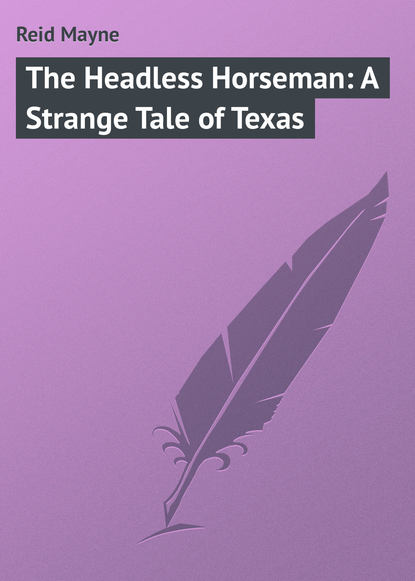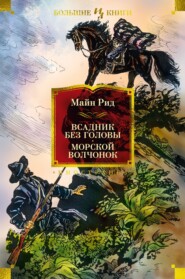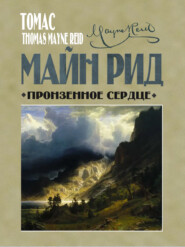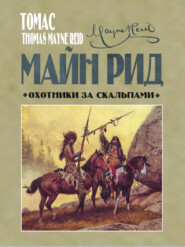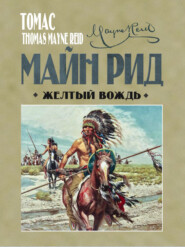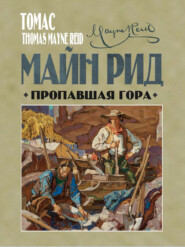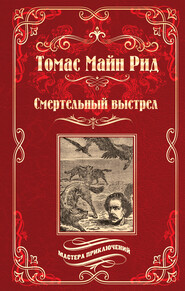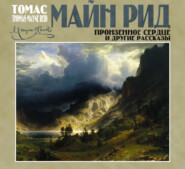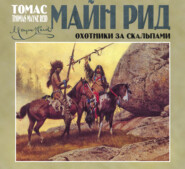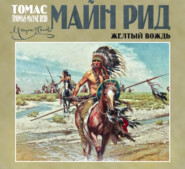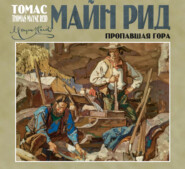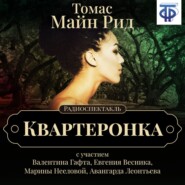По всем вопросам обращайтесь на: info@litportal.ru
(©) 2003-2024.
✖
The Headless Horseman: A Strange Tale of Texas
Настройки чтения
Размер шрифта
Высота строк
Поля
For over an hour did the atmosphere carry this cinereous cloud; during which period lasted the imprisonment of the travellers.
At length a voice, speaking close by the curtains of the carriole, announced their release.
“You can come forth!” said the stranger, the crape scarf thrown back above the brim of his hat. “You will still have the storm to contend against. It will last to the end of your journey; and, perhaps, for three days longer. But you have nothing further to fear. The ashes are all swept off. They’ve gone before you; and you’re not likely to overtake them this side the Rio Grande.”
“Sir!” said the planter, hastily descending the steps of the carriage, “we have to thank you for – for – ”
“Our lives, father!” cried Henry, supplying the proper words. “I hope, sir, you will favour us with your name?”
“Maurice Gerald!” returned the stranger; “though, at the Fort, you will find me better known as Maurice the mustanger.”
“A mustanger!” scornfully muttered Calhoun, but only loud enough to be heard by Louise.
“Only a mustanger!” reflected the aristocratic Poindexter, the fervour of his gratitude becoming sensibly chilled.
“For guide, you will no longer need either myself, or my lazo,” said the hunter of wild horses. “The cypress is in sight: keep straight towards it. After crossing, you will see the flag over the Fort. You may yet reach your journey’s end before night. I have no time to tarry; and must say adieu.”
Satan himself, astride a Tartarean steed, could not have looked more like the devil than did Maurice the Mustanger, as he separated for the second time from the planter and his party. But neither his ashy envelope, nor the announcement of his humble calling, did aught to damage him in the estimation of one, whose thoughts were already predisposed in his favour – Louise Poindexter.
On hearing him declare his name – by presumption already known to her – she but more tenderly cherished the bit of cardboard, chafing against her snow-white bosom; at the same time muttering in soft pensive soliloquy, heard only by herself: —
“Maurice the mustanger! despite your sooty covering – despite your modest pretence – you have touched the heart of a Creole maiden. Mon Dieu—mon Dieu! He is too like Lucifer for me to despise him!”
Chapter Five.
The Home of the Horse-Hunter
Where the Rio de Nueces (River of Nuts) collects its waters from a hundred tributary streams – lining the map like the limbs of a grand genealogical tree – you may look upon a land of surpassing fairness. Its surface is “rolling prairie,” interspersed with clumps of post-oak and pecân, here and there along the banks of the watercourses uniting into continuous groves.
In some places these timbered tracts assume the aspect of the true chapparal– a thicket, rather than a forest – its principal growth being various kinds of acacia, associated with copaiva and creosote trees, with wild aloes, with eccentric shapes of cereus, cactus, and arborescent yucca.
These spinous forms of vegetation, though repulsive to the eye of the agriculturist – as proving the utter sterility of the soil – present an attractive aspect to the botanist, or the lover of Nature; especially when the cereus unfolds its huge wax-like blossoms, or the Fouquiera splendens overtops the surrounding shrubbery with its spike of resplendent flowers, like a red flag hanging unfolded along its staff.
The whole region, however, is not of this character. There are stretches of greater fertility; where a black calcareous earth gives nourishment to trees of taller growth, and more luxuriant foliage. The “wild China” – a true sapindal– the pecân, the elm, the hackberry, and the oak of several species – with here and there a cypress or Cottonwood – form the components of many a sylvan scene, which, from the blending of their leaves of various shades of green, and the ever changing contour of their clumps, deserves to be denominated fair.
The streams of this region are of crystal purity – their waters tinted only by the reflection of sapphire skies. Its sun, moon, and stars are scarcely ever concealed behind a cloud. The demon of disease has not found his way into this salubrious spot: no epidemic can dwell within its borders.
Despite these advantages, civilised man has not yet made it his home. Its paths are trodden only by the red-skinned rovers of the prairie – Lipano or Comanche – and these only when mounted, and upon the maraud towards the settlements of the Lower Nueces, or Leona.
It may be on this account – though it would almost seem as if they were actuated by a love of the beautiful and picturesque – that the true children of Nature, the wild animals, have selected this spot as their favourite habitat and home. In no part of Texas does the stag bound up so often before you; and nowhere is the timid antelope so frequently seen. The rabbit, and his gigantic cousin, the mule-rabbit, are scarcely ever out of sight; while the polecat, the opossum, and the curious peccary, are encountered at frequent intervals.
Birds, too, of beautiful forms and colours, enliven the landscape. The quail whirrs up from the path; the king vulture wheels in the ambient air; the wild turkey, of gigantic stature, suns his resplendent gorget by the side of the pecân copse, and the singular tailor-bird – known among the rude Rangers as the “bird of paradise” – flouts his long scissors-like tail among the feathery fronds of the acacia.
Beautiful butterflies spread their wide wings in flapping flight; or, perched upon some gay corolla, look as if they formed part of the flower. Huge bees (Meliponae), clad in velvet liveries, buzz amid the blossoming bushes, disputing possession with hawkmoths and humming-birds not much larger than themselves.
They are not all innocent, the denizens of this lovely land. Here the rattlesnake attains to larger dimensions than in any other part of North America, and shares the covert with the more dangerous moccasin. Here, too, the tarantula inflicts its venomous sting; the scorpion poisons with its bite; and the centipede, by simply crawling over the skin, causes a fever that may prove fatal!
Along the wooded banks of the streams may be encountered the spotted ocelot, the puma, and their more powerful congener, the jaguar; the last of these felidae being here upon the northern limit of its geographical range.
Along the edges of the chapparal skulks the gaunt Texan wolf – solitarily and in silence; while a kindred and more cowardly species, the coyoté, may be observed, far out upon the open plain, hunting in packs.
Sharing the same range with these, the most truculent of quadrupeds, may be seen the noblest and most beautiful of animals – perhaps nobler and more beautiful than man – certainly the most distinguished of man’s companions – the horse!
Here – independent of man’s caprice, his jaw unchecked by bit or curb, his back unscathed by pack or saddle – he roams unrestrained; giving way to all the wildness of his nature.
But even in this, his favourite haunt, he is not always left alone. Man presumes to be his pursuer and tamer: for here was he sought, captured, and conquered, by Maurice the Mustanger.
On the banks of the Alamo– one of the most sparkling streamlets that pay tribute to the Nueces – stood a dwelling, unpretentious as any to be found within the limits of Texas, and certainly as picturesque.
Its walls were composed of split trunk of the arborescent yucca, set stockade-fashion in the ground; while its roof was a thatch furnished by the long bayonet-shaped loaves of the same gigantic lily.
The interstices between the uprights, instead of being “chinked” with clay – as is common in the cabins of Western Texas – were covered by a sheeting of horse-skins; attached, not by iron tacks, but with the sharp spines that terminate the leaves of the pita plant.
On the bluffs, that on both sides overlooked the rivulet – and which were but the termination of the escarpment of the higher plain – grew in abundance the material out of which the hut had been constructed: tree yuccas and magueys, amidst other rugged types of sterile vegetation; whereas the fertile valley below was covered with a growth of heavy timber – consisting chiefly of red-mulberry, post-oak, and pecân, that formed a forest of several leagues in length. The timbered tract was, in fact, conterminous with the bottom lands; the tops of the trees scarce rising to a level with the escarpment of the cliff.
It was not continuous. Along the edge of the streamlet were breaks – forming little meads, or savannahs, covered with that most nutritious of grasses, known among Mexicans as grama.
In the concavity of one of these, of semicircular shape – which served as a natural lawn – stood the primitive dwelling above described; the streamlet representing the chord; while the curve was traced by the trunks of the trees, that resembled a series of columns supporting the roof of some sylvan coliseum.
The structure was in shadow, a little retired among the trees; as if the site had been chosen with a view to concealment. It could have been seen but by one passing along the bank of the stream; and then only with the observer directly in front of it. Its rude style of architecture, and russet hue, contributed still further to its inconspicuousness.
The house was a mere cabin – not larger than a marquee tent – with only a single aperture, the door – if we except the flue of a slender clay chimney, erected at one end against the upright posts. The doorway had a door, a light framework of wood, with a horse-skin stretched over it, and hung upon hinges cut from the same hide.
In the rear was an open shed, thatched with yucca leaves, and supported by half a dozen posts. Around this was a small enclosure, obtained by tying cross poles to the trunks of the adjacent trees.
A still more extensive enclosure, containing within its circumference more than an acre of the timbered tract, and fenced in a similar manner, extended rearward from the cabin, terminating against the bluff. Its turf tracked and torn by numerous hoof-prints – in some places trampled into a hard surface – told of its use: a “corral” for wild horses —mustangs.
This was made still more manifest by the presence of a dozen or more of these animals within the enclosure; whose glaring eyeballs, and excited actions, gave evidence of their recent capture, and how ill they brooked the imprisonment of that shadowy paddock.
The interior of the hut was not without some show of neatness and comfort. The sheeting of mustang-skins that covered the walls, with the hairy side turned inward, presented no mean appearance. The smooth shining coats of all colours – black, bay, snow-white, sorrel, and skewbald – offered to the eye a surface pleasantly variegated; and there had evidently been some taste displayed in their arrangement.
The furniture was of the scantiest kind. It consisted of a counterfeit camp bedstead, formed by stretching a horse-hide over a framework of trestles; a couple of stools – diminutive specimens on the same model; and a rude table, shaped out of hewn slabs of the yucca-tree. Something like a second sleeping place appeared in a remote corner – a “shakedown,” or “spread,” of the universal mustang-skin.
What was least to be expected in such a place, was a shelf containing about a score of books, with pens, ink, and papéterie; also a newspaper lying upon the slab table.
Further proofs of civilisation, if not refinement, presented themselves in the shape of a large leathern portmanteau, a double-barrelled gun, with “Westley Richards” upon the breech; a drinking cup of chased silver, a huntsman’s horn, and a dog-call.
Upon the floor were a few culinary utensils, mostly of tin; while in one corner stood a demijohn, covered with wicker, and evidently containing something stronger than the water of the Alamo.
Other “chattels” in the cabin were perhaps more in keeping with the place. There was a high-peaked Mexican saddle; a bridle, with headstall of plaited horsehair, and reins to correspond; two or three spare serapés, and some odds and ends of raw-hide rope.
Such was the structure of the mustanger’s dwelling – such its surroundings – such its interior and contents, with the exception of its living occupants – two in number.
On one of the stools standing in the centre of the floor was seated a man, who could not be the mustanger himself. In no way did he present the semblance of a proprietor. On the contrary, the air of the servitor – the mien of habitual obedience – was impressed upon him beyond the chance of misconstruction.
Rude as was the cabin that sheltered him, no one entering under its roof would have mistaken him for its master.
Not that he appeared ill clad or fed, or in any way stinted in his requirements. He was a round plump specimen, with a shock of carrot-coloured hair and a bright ruddy skin, habited in a suit of stout stuff – half corduroy, half cotton-velvet. The corduroy was in the shape of a pair of knee-breeches, with gaiters to correspond; the velveteen, once bottle green, now faded to a brownish hue, exhibited itself in a sort of shooting coat, with ample pockets in the breast and skirts.





